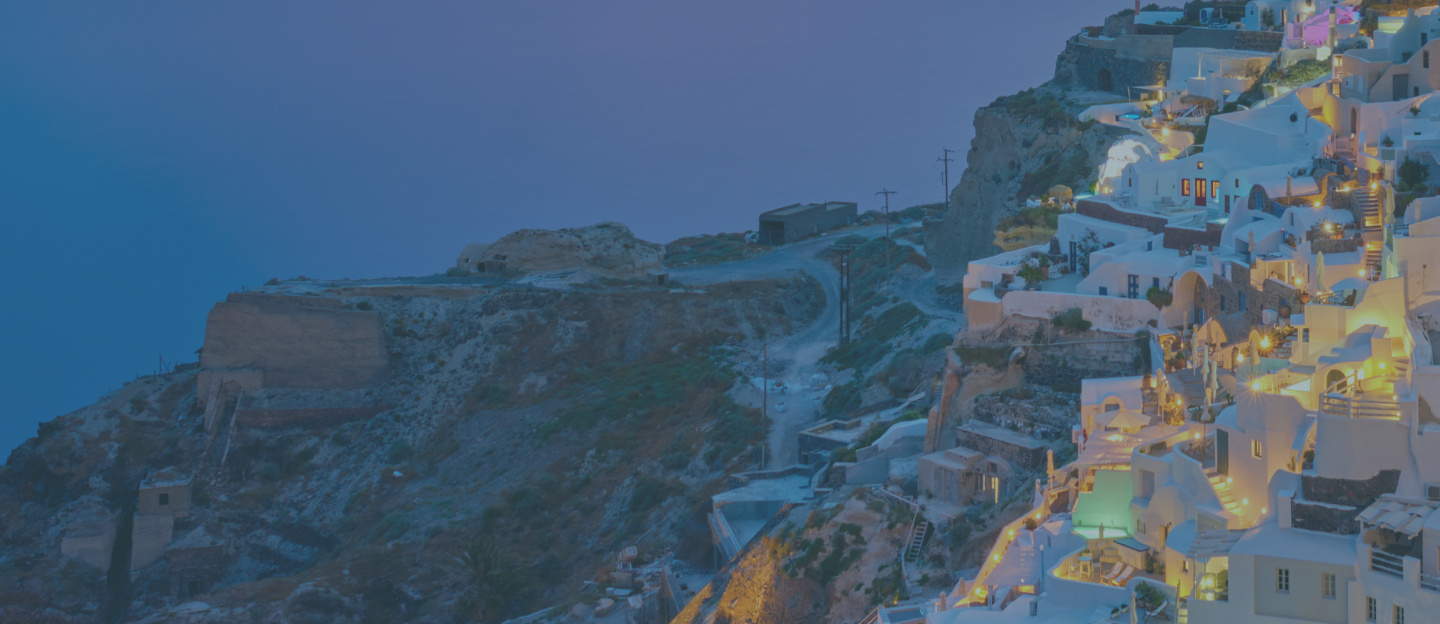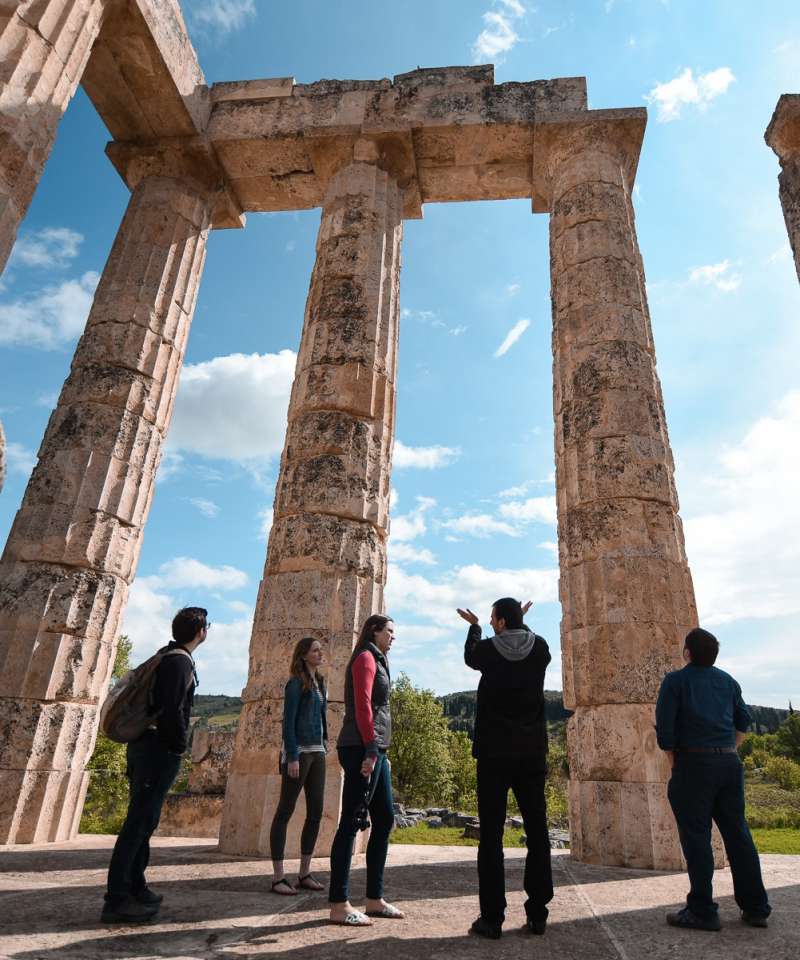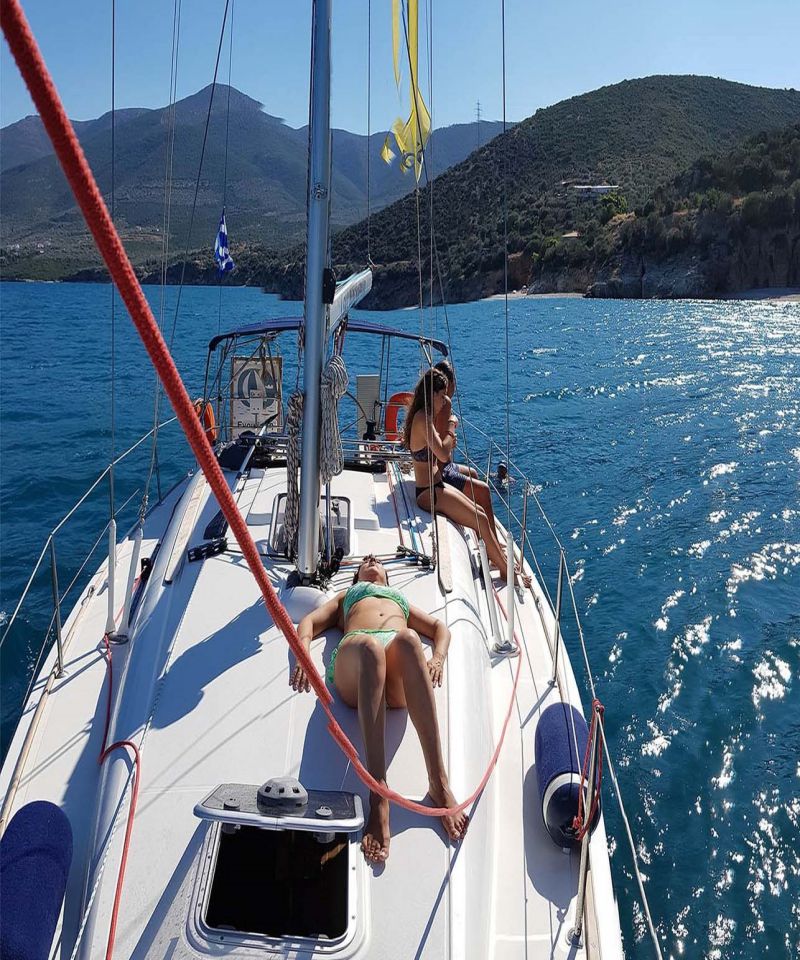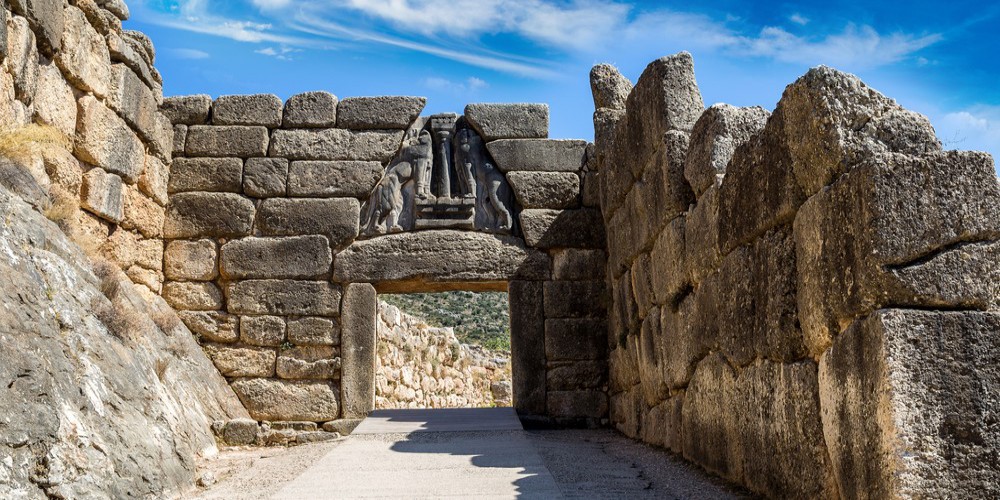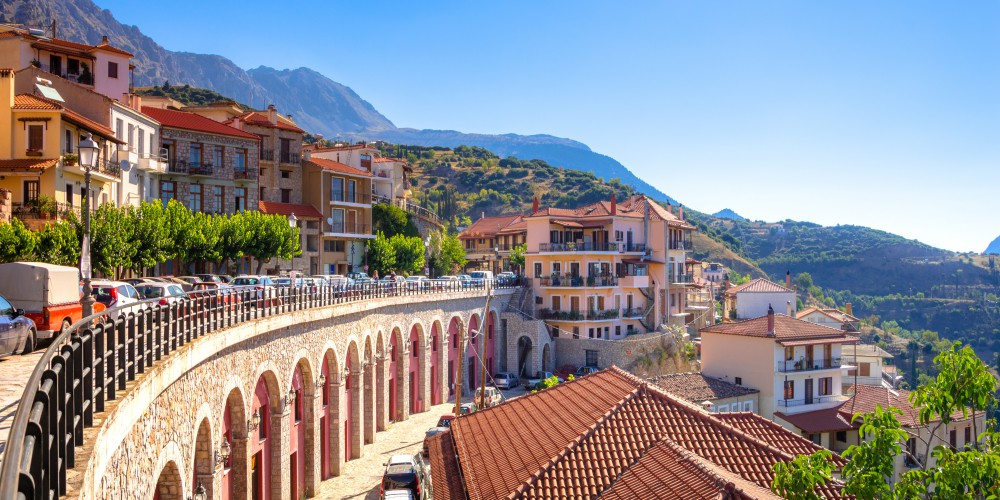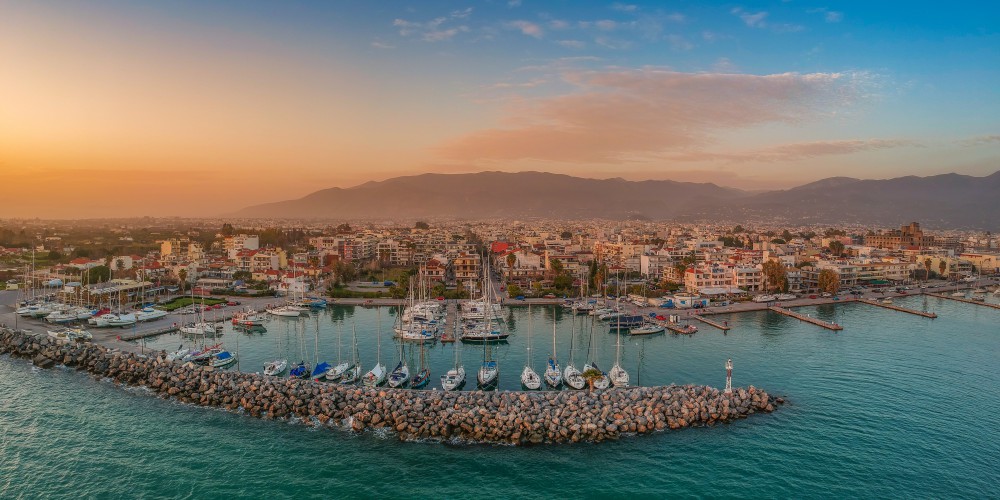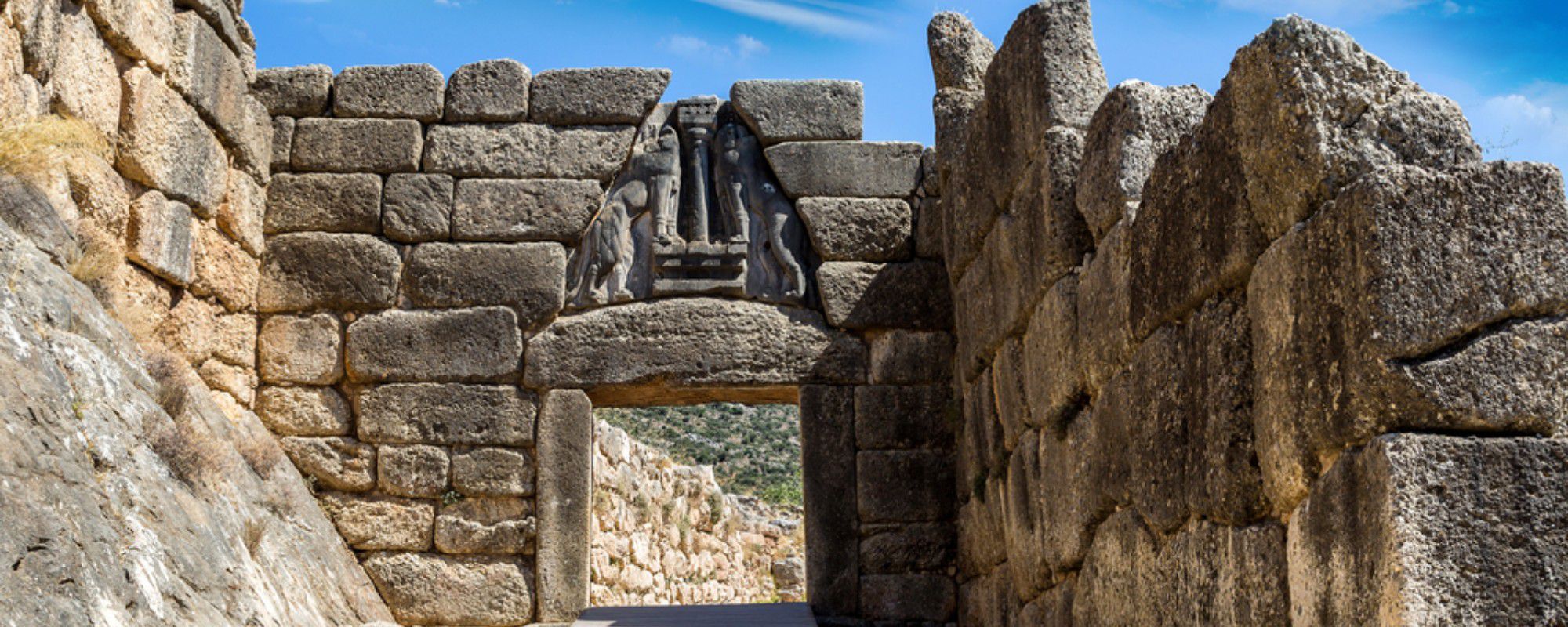
Peloponnese: The Definitive Travel Guide
Key Takeaways:
- The Peloponnese is home to important archaeological sites such as Mycenae, Olympia, Epidaurus, and Ancient Messene, showcasing the region's historical significance.
- Visitors can explore beautiful beaches, hike in national parks like the Taygetus and Parnon Mountains, and admire picturesque landscapes such as the Mani Peninsula and the Diros Caves.
- The Peloponnese is dotted with medieval fortresses, including the Palamidi Fortress in Nafplio, the Acrocorinth in Corinth, and the Mystras Fortress near Sparta.
- Visitors can explore vineyards and wineries, taste regional wines such as Agiorgitiko and Moschofilero, and savor local dishes like 'spetzofai' (sausage with peppers).
Peloponessos – there is something magical about the name and something mythical in all that is contained within.
‘The island of Pelops,’ derived from the mythical king Pelops who supposedly unified the region, is a name first used during the Greek Archaic period (800-479 BC).
Today, the Peloponnese conjures up visions of the most exotic traces of the Hellenic past. Sparta, Mycenae, Olympia, Argos, Corinth; relics of a distant age.
The Peloponnese peninsula is a peninsula that actually borders Central Greece, not an island, joined to mainland Greece by the isthmus of Corinth and separated by a strip of water from Hydra island.
It is littered with ancient ruins and important archaeological sites, attesting to the brilliant flourishing of the great Hellenic ages.
Let us take you on a journey through this land of myth and raw beauty.
Standing at the top of Taygetos, or as it was called from Byzantine times until the 19th century, Pentadaktilos, mentioned in the Odyssey as the tallest peak on the Peloponnese at 2,407 meters, you can survey the vast landscape around you.
Here, you can find a guide around all regions of the Peloponnese that will offer you valuable insight into a magical and often overlooked side of Greece and help you fill your Greek bucket list.
Corinthia
Ancient Corinth
In winter, in western Peloponnese, the white peaks of Taygetos glimmer in the distance as you stroll around the beautiful Temple of Apollo and the ancient Agora in the ancient city of Corinth.
Rising majestically behind this site is the imposing rock fortress of Acrocorinth, the Acropolis of Corinth.
From there, you will feel like the whole of mainland Greece, and especially the Peloponnese is yours. This is indeed the gateway to the peninsula and has been heavily fortified over the centuries.
The temple of Apollo in the ancient city of Corinth - credits: WitR/Shutterstock.com
Commanding the heights above the isthmus, would-be conquerors had to reckon with the heights of Acrocorinth. The walls you will see winding their way around the rocky outcrop were constructed and used by the Byzantines, Venetians, and Ottomans.
You will also come across the ruins of the sanctuary of Goddess Aphrodite. Much like the Parthenon in Athens, this sanctuary was converted into a church in Byzantine times before becoming a mosque under the Ottomans.
Loutraki
If you want to escape from Athens with a quick trip to the Greek mainland, Loutraki, a seaside town in the Peloponnese, only one hour away from Athens by car, is the ideal destination for you, also accessible by bus and the suburban train.
But what makes Loutraki so special?
We love Loutraki for many reasons:
- It is close to the Greek capital, so you can easily get to it by car in about an hour when you visit Athens. The route to north Peloponnese is beautiful, so the drive is also enjoyable. Just wear your sunglasses and enjoy the beauty of the Greek landscape.
- Loutraki has great nightlife, especially in summer. There are many beach bars along the length of the central road, as well as restaurants and cafes with tables by the sea, where you can enjoy your coffee or ice cream while staring at the endless Greek sea.
- There is plenty of choice for accommodation in Loutraki, such as hotels and rooms to let. Depending on your budget, you can either stay at a place next to the beach or book a room in a hotel placed on the main road.
The landscape of Heraion lake, Peloponnese - credits: photo stella/Shutterstock.com
- Loutraki has a long story in the spa and thermalism facilities. The water derived from the Loutraki natural thermal springs has been characterized as “The Water of Life” since antiquity. Today, Loutraki Thermal Spa is the best place to relax while enjoying a massage session or a hydromassage in an individual bathtub in your private cabin.
- Loutraki is also great for those who love trekking. There are some great trekking routes up the Geraneia mountain, or from Sterna to the lighthouse of Heraion.
- It is also the best choice for all of you that like to gamble from time to time. Club Hotel Casino Loutraki is the biggest casino in Greece, as well as one of the biggest casinos in Europe, but also a fantastic 5* hotel, offering the perfect setting for relaxation.
A hidden gem: Limni Vouliagmeni
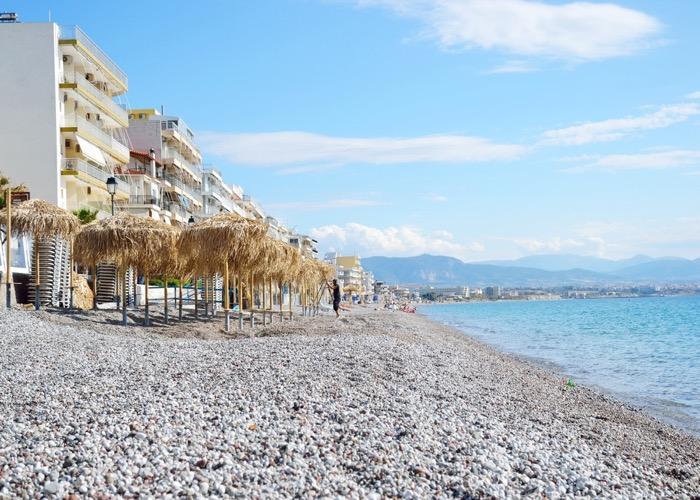
Limni Vouliagmeni is a great place to swim and taste the luscious flavors of a traditional Greek meal by the sea.
To find and explore this secret spot, just drive from Loutraki via the seaside road, following the signs to Perachora and then to Limni Vouliagmenis.
Limni Vouliagmeni's waters communicate with the waters of the Corinthian Gulf from a very narrow channel in its southern part, but it is a great swimming spot, as you can choose to lay down either at one of the sun lounges of the organized beach or on the sandy coast by yourself.
Cape Heraion is only 3 km away and is worth visiting, as it combines the beauty of ancient Corinthian civilization with the crystal-clear waters of a small beach next to it.
The Heraion of Perachora was a sanctuary of the goddess Hera. The ruins placed next to the beach belong to the temple of Hera Limenaia.
Lakonia
Sparta
Approximately 20 km to the northeast lies the ancient site of Sparta. Today Sparta -or Sparti in Greek- is a small town of approximately 20,000 inhabitants, however, all around the town are traces of a much more sizeable historical significance.
The ruins of ancient Sparta tell the story of a great city-state in ancient Greece, which by 650 BC had become the preeminent military power in Greece.
Sparta was indeed unique in Greece, known for its social system and constitution being overwhelmingly focused on military preparation and excellence.
“Genuine sons of Sparta bold!
Firm and full your bucklers hold:
With intrepid step advance:
Poise and point the vengeful lance.
Life despises and dares to fall:
Glory and your country call!"
- Select Essays of Dio Chrysostom, Greek orator, writer, philosopher & historian of the Roman Empire (1st century)
After leading the Greek resistance to the Persian invasion in the early part of the 5th century BC, Sparta contested the Peloponnesian War with Athens between 431 and 404 BC, emerging victorious – although at great cost.
Sparta was subsequently faced with another challenge to its power: Corinth formed an alliance with Argos, Boeotia, Thebes, and Athens to fight Sparta in the Corinthian Wars of 395-386 BC. This alliance was also defeated.
The dominant force in Greece did, however, eventually lose its crown. Sparta lost to Thebes at the Battle of Leuctra in 371 BC, a defeat that marked its decline as the leading military power in the land, a decline that was never reversed.
Ancient Corinth, Peloponnese - credits: Tatiana Popova/Shutterstock.com
Mani
I have been on Taygetos for some time now. I’m hot and in need of a refreshing swim. The Peloponnese is absolutely awash with bays and beaches. The choices are endless – and simply stunning.
I can see two beautiful bays just to the southwest of where I stand now. Stoupa and Kardamyli are utterly delightful, full of charm and elegance. The beaches surrounding these two towns are to be savored.
The famous Greek writer Nikos Kazantzakis traveled to Stoupa with Giorgos Zorbas, whom he employed as foreman of his nearby lignite mine. The relationship between the two inspired Kazantzakis’s book Zorba the Greek.
Further north lies scenic Kardamyli, mentioned by Homer in the Iliad as one of seven cities offered by Agamemnon to Achilles to persuade him to return to the Trojan battlefield.
Its buildings are an amalgam of Greek and Venetian architecture, and the town offers unparalleled views of our favorite mountain, Taygetos.
Methoni Venetian Fortess, villages in Greece - credits: Greeking.me
Stoupa and Kardamyli are situated at the northern end of the Mani Peninsula, a place whose unofficial flag talks of victory or death.
That more or less sums up the prevailing historical attitude of this untamed land. The area’s remoteness, at the far reaches of the Peloponnese, made it extremely difficult to administer.
Successive empires felt their authority hang by a thread in this mountainous outpost. The Byzantine Empire struggled to impose control, whilst Franks and Saracens battled for supremacy over Mani’s rebellious hinterland.
Forts were built by the crusaders of the Fourth Crusade in the early 13th century before the peninsula once again returned to Byzantine suzerainty in 1262.
After the fall of Constantinople, Mani’s new overlords were Ottoman, but this was purely nominal. In exchange for an annual tribute (that was only paid once), the peninsula was ruled by local chieftains.
One of the unique features of this enchanted landscape is the tower house, prominent in villages such as Vatheia, a symbol of the fortified and unbowed nature of this fiercely independent land.
Vatheia, Mani, Peloponnese - credits: Greeking.me
Three further beaches, or areas of beaches, recommend themselves. Heading west to the Messenian peninsula, the outlandishly beautiful strip of sand of Voidokilia cries out to be lain on.
Guarding the entrance to its pristine horseshoe bay are two fortresses, one Frankish, and one Ottoman.
The Frankish fort, built in the 1280s, is called Old Navarino castle – Navarino (from the Greek Avarinos) being the Italian name used for the town of Pylos since Frankish rule was established in the 13th century. The town was also known by its French name, Port-de-Jonc.
After a brief period of Venetian rule, the Ottomans conquered Messenia and built the New Navarino castle to protect their newly-established naval base.
Above Voidokilia beach is the cave of Nestor, king of Pylos in the Iliad. In Greek mythology, this is the cave where Hermes hid the cattle stolen from Apollo.
Overlooking the beach at the northern end is the tomb of Nestor’s son, Thrasymedes.
These Mycenaean civilization-era features of the landscape are not the oldest by any means. Neolithic remains indicate habitation at the site from as early as 4000 BC.
Voidikilia beach is Homer’s ‘sandy Pylos’ where Telemachus was welcomed by Nestor during the search for his father, Odysseus:
We left for Pylos, Nestor too
the shepherd of the peoples,
And He, receiving me the king,
within his halls so lofty,
Embraced me with all
eagerness as a father does
his youngling
His son back from a long time abroad.
- Homer, Odyssey
XVII 108-112
Let me take you east now to the most easterly of the three peninsulas jutting down from the main body of land. Like the teeth of the indented Mulberry leaf, the peninsulas of Messenia, Mani, and Malea reach out as if the beauty of the Peloponnese were a painting whose excess of color could not be contained within the frame, dripping beneath the margins.
Just off the coast of Cape Malea lies Elafonisos, a small expanse of land with exquisite beaches and wonderfully clear water.
Elafonisos was connected to the mainland until 1677. The most beautiful of the beaches is Simos, divided in two by a headland that creates a delightful bay to the south.
The whiteness of the sand, the clarity of the turquoise water, and the wildness of the dunes backing onto the beach make this one of the most stunning beaches in all of Greece.
Views from Mani, Peloponnese - credits: Greeking.me
The beach of Kato Nisi on the west coast is also well worth visiting, its expanse of white sand, clear water, and pine trees making it a place eminently capable of taking your breath away.
Around 200 meters off the coast of Elafonisos, to the northeast, is the sunken city of Pavlopetri, lost to the sea around 1000 BC.
Dating from the 3rd millennium BC, the city is the oldest of its type in the Mediterranean and quite possibly the world. Its layout remains unchanged after 5,000 years, despite the erosion of the millennia.
Monemvasia
Finally, let us move northeast to the eastern coast of Malea. Here we find the once-impregnable fortified town of Monemvasia, today a tourist hotspot. Monemvasia, meaning ‘single entrance,’ seems almost incongruous, rising from the sea like some hulking iceberg terribly far from home.
Its unlikeliness makes it all the more beautiful. Sheer cliff faces 100m in height and drops into the sea, whilst on its southern flank, a delightful village leans up against the walls of rock. The town walls and numerous Byzantine churches - especially in the upper town- remain from the Medieval period.
Monemvasia was a powerful Medieval fortress with fortifications dating back to 583 when inhabitants of the mainland sought refuge from invading Slavic and Avaric groups.
As a Byzantine fortress, it withstood Arab and Norman invasions in advance of changing hands several times in the usual way – from the Franks of the Crusades and back to Byzantine hands, before moving on to the Venetians and Ottomans.
After the fall of Constantinople, Monemvasia held out twice against the Ottomans in 1458 and 1460 and became the last remaining possession of the Despot of Morea, Thomas Palaiologos (claimant of the Byzantine imperial throne). Eventually, the island fortress succumbed.
Monemvasia, Peloponnese - Image owned by Greeking.me
The 20th century produced the most famous son of Monemvasia. The poet and left-wing activist
Yiannis Ritsos was born here in 1909. Ritsos is considered one of the five great Greek poets of the 20th century, alongside Kavafis, Kariotakis, Seferis, and Elytis.
The French surrealist poet Louis Aragon described him as ‘the greatest poet of our age.’ On nine separate occasions, he was put forward for the Nobel Prize for Literature without success.
Ritsos joined the KKE (Greek Communist Party) in 1931 and lived a life of political struggle.
His groundbreaking work Epitaphios, published in 1936, was publicly burned at the foot of the Acropolis by the right-wing dictatorship of Ioannis Metaxas, whilst in 1967, he was again the victim of the authoritarian rule when he was sent to a prison camp by the Papadopoulos military junta.
In between these two periods of censorship and repression, Ritsos fought in the Greek Resistance against the Axis occupation, joining the National Liberation Front in 1941.
At the end of World War II, civil war erupted in Greece (1946-1949), and Ritsos, on the side of the left, was arrested and imprisoned. Confined to prison between 1948 and 1952, Ritsos gained truly iconic status, and his poem Epitaphios, set to music by Mikis Theodorakis, became the anthem of the Greek left.
The poem Romiosini – a term that contains within it much of what it means to be a Greek connected with the whole spectrum of one’s national past, especially of the Greco-Roman fusion concretized in the Eastern Roman Empire, i.e., the Byzantine Empire – provides a flavor of Ritsos’s work, of his combining of Greek tradition, struggle, and the natural realm:
These trees don’t take comfort in less sky
these rocks don’t take comfort under foreigners’
footsteps
these faces don’t take comfort but only
in the sun
these hearts don’t take comfort except in justice
This landscape is merciless like silence
it hugs its fiery rocks tightly in its bosom
it hugs tightly in the sun its orphan olive trees
and grapevines
it clenches its teeth There is no water Only light
-Yiannis Ritsos, Romiosini
Elis or Ilia
Olympia
Standing once again upon the grand peaks of Taygetos, you will strain my eyes against the brilliant horizon. Innumerable centuries of history clatter through my mind, like the unbound hooves of Alexander’s Bucephalus.
Those hooves touched these lands, that noble and great conqueror walked through the gateway of this enchanted peninsular; he needed to proceed no further than Corinth to assert his authority.
All of Greece was his. Standing atop Taygetos, it feels as if all of Greece is here. If you look northwest, towards the setting sun, know that somewhere over there lies the ancient site of Olympia. Olympia! The very name connotes such grandeur!
This was the site of the Olympic Games, held every four years, from the 8th century BC to the 4th century AD.
The Games, set up by King Pelops, were originally intended as a celebration of the god Zeus, and therefore had a particularly pagan quality. As time went by events were added and the Games took on a more overtly sporting nature.
The Olympics were dedicated to the Olympian gods in general, as well as to Zeus, and formed part of the Panhellenic Games – a series of four sports festivals including those at Delphi, Nemea, and Isthmia.
They were outlawed, however, in 396 AD by the Roman Emperor Theodosius as part of the drive to install Christianity as the state religion of Rome on the grounds that they were representative of a pagan cult.
Archaeological Site of Olympia, Peloponnese - credits: Greeking.me
Treading in the footsteps of Olympic greats from millennia past, you will run into the stadium and explore the gymnasium – a truly heroic experience.
Beyond these places of the sporting legend you will discover the Altis, the sanctuary of the gods, and within it, the Philippeion.
This Ionic circular memorial to Philip II of Macedon, the father of Alexander the Great, contains statues of Philip himself, Alexander, and Olympias, Alexander’s mother.
You will also wander between the fallen Doric columns of the Temple of Zeus and behold the Sanctuary of Hera, queen of the gods. Olympia has a resonance that transcends the ages and speaks of the glories of ancient Greece.
It is also a reminder of the ephemerality of things; after being damaged and desecrated by the Romans, Olympia fell into ruin after successive natural disasters in the 6th and 7th centuries.
Justinian’s plague (named after the Byzantine emperor of the time), which wiped out around 13% of the world’s population, was followed by two deadly earthquakes before repeated floods finally did for Olympia.
Ancient Olympia, Peloponnese - credits: Greeking.me
Argos
From the summit of Taygetos, off in the far distance, and also to the northeast, you can see Argos, Mycenae, and Corinth. Argos is one of the oldest continually inhabited places in the world, with its inhabitation dating back some 7,000 years!
The name of Argos is indeed ancient, derived as it is from the Pelasgian word for ‘plain.’
The Pelasgian language belongs to the pre-classical period of Greek. Located on the Argolic plain are numerous sites from antiquity.
Why not discover these places and sites such as ancient Mycenae in the company of our deeply knowledgeable, local guide as part of our tour of Argolis?
Ruins in Ancient Corinth, Peloponnese - credits: Tatiana Popova/Shutterstock.com
Argolis
Let us welcome you to Argolis, one of the most beautiful locations on the Peloponnesian peninsula. This region offers a unique combination of mountains and sea, art and history, and picturesque villages infiltrated with olive trees.
Argolis' capital, Nafplio, is one of the most important and picturesque cities in Greece; a seaport city that was the first official capital of newly-liberated Greece in 1829.
The regional unit of Argolis also includes the magnificent city of Epidaurus, where the exceptional Theatre of Epidaurus is located, and the ancient city of Mycenae, one of the major centers of Greek civilization from about 1600 BC to 1100 BC.
Last but not least, the beautiful seafront city of Ermioni.
Mycenae
Mycenae – the home of the legendary Agamemnon and the source of the name given to the era of Greek history spanning the years 1600 – 1100 BC, the Mycenaean period. Agamemnon, brother of Menelaus, was king of Mycenae.
When Helen, Menelaus’s wife, was kidnapped by Paris and taken to Troy, Agamemnon commanded the Greek forces in the ensuing Trojan Wars.
Mycenae, in many ways, therefore, represents the epicenter of Greek cultural history. Homer’s Iliad and Odyssey are based on these Mycenaean exploits.
You can visit the archaeological site of Mycenae, taking in the Cyclopean Walls, the Royal Tombs, and the Treasury of Atreus.
The Lion’s Gate, the main entrance to the Bronze Age citadel, dates from the 13th century BC and is the sole surviving example of Mycenaean monumental sculpture.
Acropolis of the Mycenae - credits: barbar34/Shutterstock.com
Nafplio
A day trip to Argolis should also include a visit to the Italianate town of Nafplio, with its distinctively Venetian architecture -resembling Corfu Town or Heraklion- and castles.
The sensational sea views from the hilltop castles overlooking the old town are a sight to behold.
The walls of the Acronafplia, the rocky peninsular extending beyond the town and dating from pre-classical times, when they were built by the ancient Greeks and were later incorporated by the Byzantines, Franks, Venetians, and Ottomans into the town proper and extended.
Climb to the top of Palamidi castle and imbibe the luxuriant view of the Argolic Gulf.
Palamidi castle - credits: Olga Kot Photo/Shutterstock.com
Nafplio, a town of just 14,000 or so, was much more important not that long ago: the ‘Naples of the East,’ as it was known to the Venetians, was the capital of the First Hellenic Republic from the first moments of Greek independence from the yoke of Ottoman rule in 1821 until 1834, when Athens took on the mantle.
It is, therefore, an integral part of the history of modern Greece.
Nafplio is, arguably, a tremendously romantic place and also a place with significant culinary culture, making it the ideal setting for a Greek cooking class.
Indulge in the invigorating culinary experience of a Nafplion sailing adventure and admire the stunning beauty of the region!
Town of Nafplio - credits: imagIN.gr photography/Shutterstock.com
Epidaurus
Another important Argolic site and one of the most important archaeological sites is Epidaurus, home of the healing center of Asclepius. The Asclepeion was the most celebrated healing sanctuary of the classical world.
A son of Apollo Epicurius, Asclepius the Paean, or Healer -an adjective he shared with his father- was a hero and the Greek god of medicine in Greek mythology and represents the healing dimension of the medical arts.
After the destruction of Corinth by the Romans in 146 BC Epidaurus gradually became less important, with raids by Romans and Goths diminishing its stature.
It was still cited as a place of healing as late as the 5th century AD, but this time as a Christian sanctuary.
The most outstanding feature of the site is the 14,000-capacity theatre, dating from the 4th century BC, and renowned for its exceptional acoustics.
Its shape was inspired by that of a seashell, and it continues to delight the human ear with an annual festival that takes place on its ground.
FAQs
When can one explore the history of Argolis?
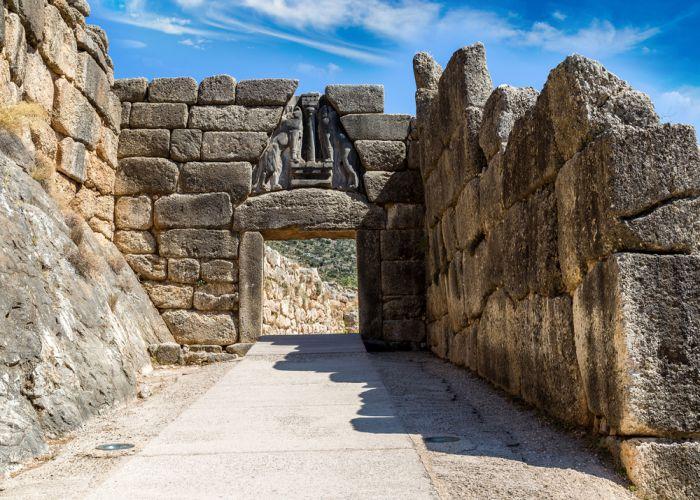
Both Greeks and visitors who admire Greek history and important archaeological sites and want to explore civic monuments which serve as trademarks and examples of various historical periods in the Greek mainland, Argolis is going to be a fascinating region to visit.
Let’s start with Mycenae, the kingdom of Homer’s Agamemnon in the Late Bronze Age and one of the most important archaeological sites in the Peloponnese.
You will be blown away as soon as you enter, as does all the Greek population; the citadel is adorned by the Lion Gate, where two lions confront each other above the entrance.
As you wander around the monuments, you will find the Treasury of Atreus or the Tomb of Agamemnon, constructed with beautifully carved blocks of stone.
However, this is not the only monument that’s related to a Homeric hero.
Palamidi, the marvelous fortress located in the city of Nafplio, has also taken its name from Palamedes, the son of Nauplius and Clymene in Greek Mythology.
This site was built by the Venetians during their second occupation in Nafplio by the end of the 17th century.
This truly significant monument has also been used as a prison, where the hero of the Greek Revolution, Theodoros Kolokotronis, had been held during the Greek War of Independence against the Ottoman occupation.
If you want to get a good photograph to take home, climb Palamidi’s many -oh, so many!- steps and admire the view from the top. It won’t be the easiest hike, but it’s totally worth it!
How is the art of acting connected to the Peloponnese?
For those who love theatre, Argolis offers perhaps the most well-preserved ancient open-air theatre of them all.
This is an opportunity for theatre lovers to visit a spectacular site. The Epidaurus Theatre is the epitome of architectural beauty and skill and has righteously earned its place on the UNESCO World Heritage list.
Even though this UNESCO World Heritage ancient theatre was built around 330 BC, it is fully functional even today. You will be amazed by its superb acoustics, which you can test out for yourself by standing in the center of the orchestra and just clapping your hands.
If there were 14,000 spectators sitting in the theatre, each and every one of them would be able to hear it loud and clear!
The theatre is still being used for plays, and the Epidaurus Summer Festival is held on an annual basis. An interesting note to mention is that the Theatre of Epidaurus has been dedicated to Asclepius, the god of medicine in Greek mythology.
How can you pass your leisure time in the Peloponnese?
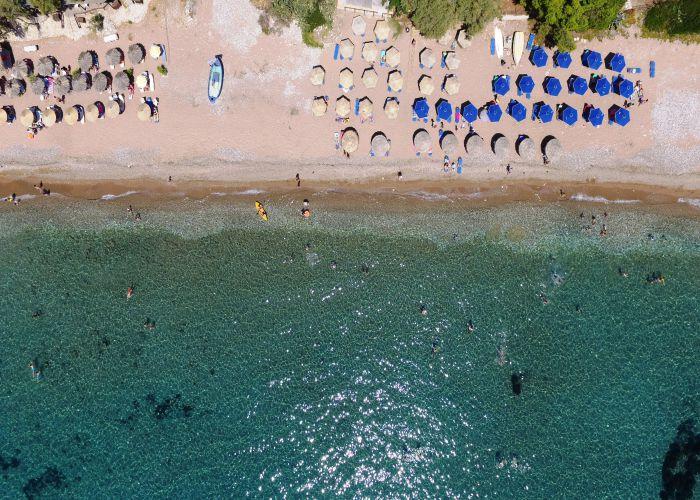
If it’s very warm outside, there are plenty of things to do to keep you busy in Argolis!
First of all, there are many beautiful beaches in Nafplio, like Arvanitia and Karathona and the tiny Neraki in between, or Yalasi in Epidaurus, where you can swim and savor the sun and the crystal blue waters.
Speaking of sea and waters, no matter where you are staying, you should definitely pass by the small port town of Ermioni, located in the southeastern part of Argolis.
It is not the typical tourist spot, but it is most definitely an off-the-beaten-path outing, where you will truly feel the local vibe and sense the serenity that seaside towns bring.
The most unforgettable long walks around a city would be in the so-called Napoli of the East, the city of Nafplio.
Filled with small pedestrian streets, pink and tile buildings, and bougainvilleas, this city will blow your mind! Its architectural beauty is one of a kind, and the historical background of this place makes it even more interesting to visit.
Make sure to spend a whole day in Nafplio, stroll around and stop by Syntagma square for ice cream.
After having walked a lot -trust us, you won’t resist exploring all the narrow streets of the city, where many small shops are hidden-you need to regain energy!
So head to the famous Staikopoulou Street and find many local restaurants with Greek delicacies and traditional homemade recipes.
The Argolic and the Saronic Gulfs surrounding the region of Argolis make a feast for your eyes as you will almost always have a wonderful sea view.
Lots of history, natural beauty, ethereal scents, and delicious gastronomy are waiting to provoke your five senses and make this experience a trip to remember!
Plan a short getaway when visiting Athens, and you'll never look back!
Peloponnese food guide
After all this adventuring, I must admit I’m pretty hungry – it’s time to eat. The Peloponnese offers so much variety, so much delicious choice, and so much that is distinctive. The peninsula is famous for the quality of its olives and, consequently its olive oil, with the regional hub of Kalamata well-known in this regard.
Also fairly ubiquitous is the wonderfully tasty aubergine, especially around the town of Leonidio, where each year at harvest time a festival is held in its honor.
The variety here is called Tsakoniki (after the region where Leonidio is located) and is light purple with white stripes. Stuffed Tsakoniki is highly recommended.
Spinach simmered with big butter beans and feta serves as a mouth-watering accompaniment to chicken, lamb, or goat.
Indeed goat is highly popular in the Peloponnese. Goat stew is a hearty winter dish to be savored.
Roasted and chopped artichokes are another local delicacy, often used in spring – in fact, artichokes are almost indispensable in Peloponnesian cooking.
Roasted with lamb to form a classic Easter dish from Mani, they are also braised with spinach and simmered with chicken and Avgolemono.
Kalamata Olives - Image owned by Greeking.me
The famous sauce of Avgolemono – made of eggs, lemon juice, and broth – also works well with stuffed vine leaves, pork, and stews. T
he use of cinnamon is widespread. It is added to dishes and sauces much more than in the rest of Greece. Indeed, a sweet touch added to dishes is fairly common throughout Peloponnesian cuisine.
Raisins and figs are thrown into a wide range of dishes, both sweet and savory.
Oranges are everywhere and used widely in cooking, as is lemon juice – especially with pork. Meat is sometimes served with a garlicky breadcrumb (Skordalia) sauce, and that meat will include rabbit.
One of the most beloved of regional dishes is a simple omelet of tomatoes and cured pork, called Kayianas. If you are a fish lover, try Savoro, a dish of marinated small fried fish served with rosemary, currants, and wild fennel.
Kayianas of eggs, tomato & cheese - Image owned by Greeking.me
Raisins or currants are paired with salted cod to create one of the most unique dishes in Greece, whilst cinnamon is added to lemon-scented braised artichokes. Other favorites include black-eyed beans – for example, simmered with chard and spinach and bunches of wild chervil.
Cabbage and pork form a fulsome winter dish. On the sweeter side of things try Diples – large dough fritters traditionally served at weddings – and Lalangia – finger-thin dough sticks.
Two final specialties worth mentioning are Chestnut Skordalia, from Arcadia in the central Peloponnese, and quails baked in bread.
Oh, and just because one should always mention Ouzo, what about Pastelli – sesame seed brittle served with Ouzo, a real favorite in local cafes.
After all this talk of food, you might be interested to discover more about Peloponnese and Greek cuisine in general. We have a range of culinary experiences to offer – I would heartily recommend these to you.
Greek spirits - Image owned by Greeking.me
To wash all this down look out for wine created from two local varieties of grape: the 'agiorgitiko' grape produces deep red, berry-infused wines popular throughout Greece.
The unusual pink Rhoditis grape is the basis for dry Patras' wines and is often mixed to make Retsina. White wine fans should seek out the Mantinia appellation, on the eastern side of the peninsula around the town of Tripoli, well-known for the light and refreshing wines the high-altitude Moschofilero grape produces.
Now we have done all this exploring and eating; it might well be time for a little siesta – choose your favorite beach upon which to drift off. And when your slumber comes to an end, you’ll awaken into a dreamscape more beautiful than anything the unconscious mind could conjure!
Sample Itinerary for 4 days in Monemvasia
Our vacation in Monemvasia has come to an end, and it's time to share our experience with you!
Monemvasia (meaning 'single entrance' in Greek) is a town in Laconia, famous for its Castle. The so-called Gibraltar of the East is the perfect place to spend some days away from the hassle and bustle of the city. We also spent one day in Elafonisos, which is a little gem at a very short distance from the southern Peloponnese and the perfect getaway when you visit Athens!
Day 1
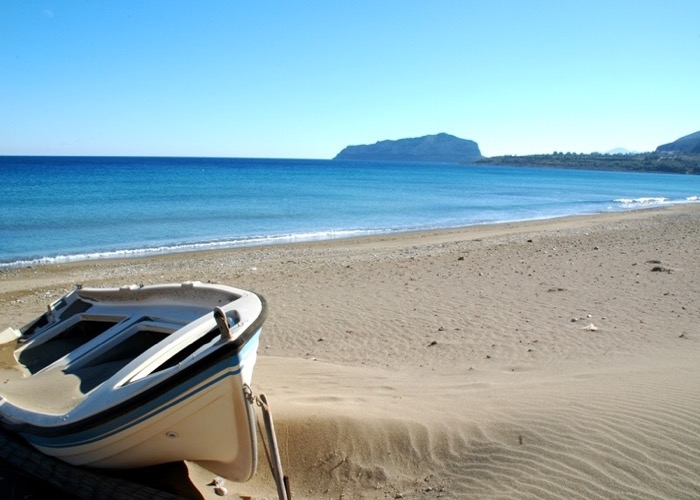
Summer holidays in Greece mean spending many hours on or by the beach. Pori beach is one of the best places for swimming, at just a short distance from Monemvasia (2-3 km).
The beach used to offer the luxury of sunbeds and umbrellas in the past, but at the moment, there is only a canteen available for refreshments.
In 2013, it was awarded a blue flag, and to this day, it is one of the cleanest and most peaceful beaches of the Peloponnese.
After our swimming adventure in Pori, we drove to Foutia, a village located 15km away from Monemvasia.
The main reason for driving up there was 'Epidilion,' a delicious restaurant with a breathtaking view, in which -if you are lucky enough to find an edge table- you will enjoy one of the most romantic dinners of your life.
The food is cooked with high-quality local products, and it is surprisingly affordable. A must-visit culinary experience if you decide to visit Monemvasia!
Day 2
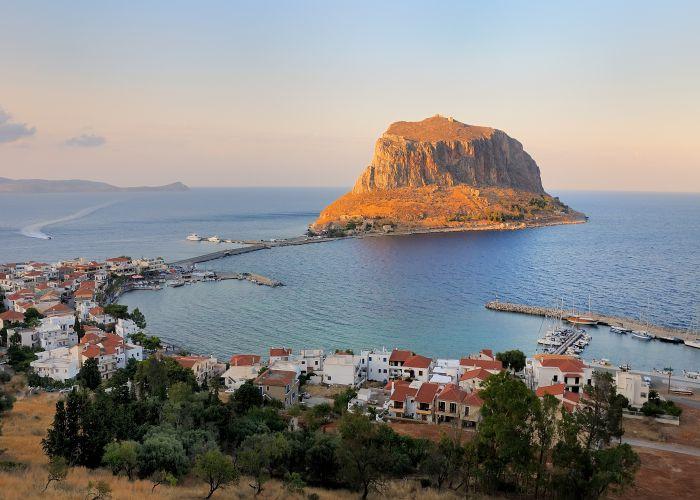
After our breakfast, we headed to the Castle of Monemvasia. Finding a parking spot on the road in front of the castle is not an easy task, so it is better to go either on foot or take the minibus from the central square.
We chose 'Enetiko cafe' for our morning coffee, a great coffee spot with a stunning balcony view. If you visit 'Enetiko Cafe,' don't miss the opportunity to taste the orange pie. Our mouths are watering just thinking about it!
Later on, we visited 'Asopitan plaz' in Plytra, less than 30 minutes away from Monemvasia. 'Asopitan' is a great beach bar-restaurant and a great choice to spend your day relaxing under the warmth of the Greek sun.
A sunbed costs only 1,5€ allowing you to afford a tasty snack and a cold, refreshing coffee as well. The beach of Plytra (named Pachiammos) has also been awarded a blue flag, certifying its excellent waters!
After spending multiple hours under the glorious sun doing absolutely nothing, we felt hungry. Our choice for dinner was 'Thalamigos Dimitra.' It is a family restaurant in Plytra port located by the sea, with mouth-watering offerings and reasonable prices.
We ordered a variety of grilled meats, pastitsio, greens, and a selection of appetizers. Having a full stomach, drinking our wine, and gazing at the sea helped us relax before returning to Monemvasia for a good night's rest.
Day 3
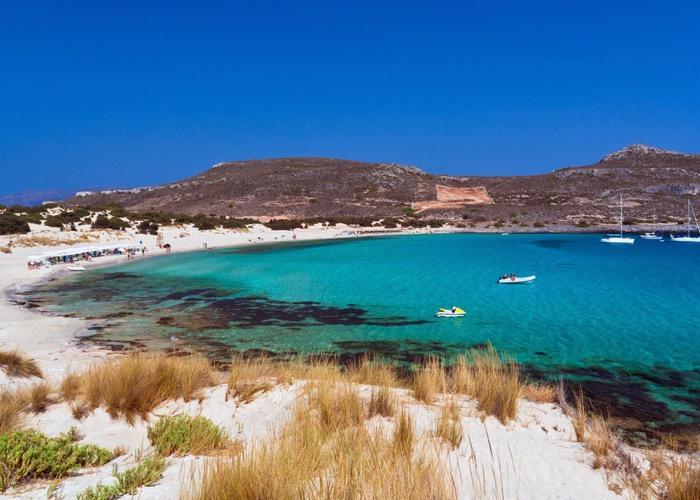
On day 3, we decided it was time to visit Elafonisos, the small island between the Peloponnese and Kythira, popular for its sandy beaches and blue-green waters.
Elafonisos is easily accessible by ferry, which leaves from Punta beach every 30 minutes, with the tickets for two people and a car costing only 12€ and the duration of the journey being approximately 15 minutes.
The most famous beaches of Elafonisos are Sarakiniko, Panagia, and Simos.
We decided to spend our morning at Simos beach, which met and surpassed our expectations. It is located in the south of the island and is a white-sand beach with crystal-clear, turquoise-colored waters and a striking view of the island of Kythira.
Simos beach is arguably one of the most beautiful beaches in Greece, one that everyone has to visit at least once in their lifetime!
Day 4
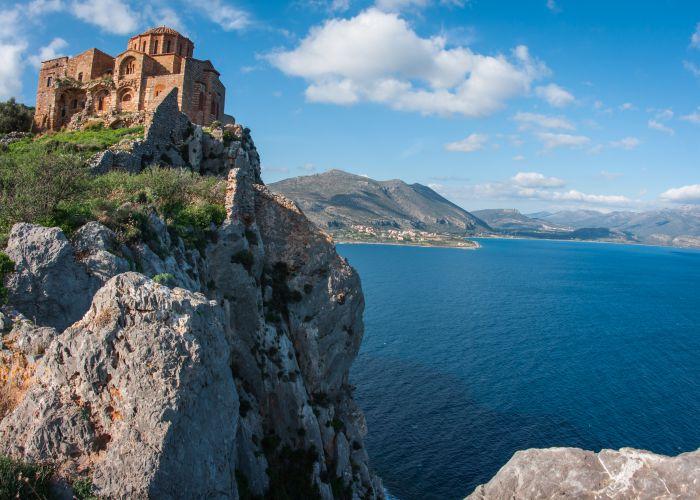
On our last day in Monemvasia, we visited the Cave of Kastania. Located near the village of Kastania on the southern tip of the Peloponnese, just minutes away from Neapoli, the route follows the winding mountain road leading to the forest-covered eastern slopes of Mount Parnon.
The cave can be accessed by following the circular route that connects Neapoli with the mountain villages Kastania, Ano Kastania, Faraklo, and Mesochori.
Rich in its density and variety of shapes, colors, and figures, Kastania Cave is classified as the second of its kind in Europe.
Nature needed three million years to create this awe-inspiring sight with its unique formations, such as the enormous red and white "waterfalls,” the gigantic columns, the “curtains” and the “sheets” that overflow like a waxwork from the roof, and the coral nests, among other magnificent creations of the earth.
In the evening, head to the port of Gerakas, a small village 25 km outside Monemvasia. This place is a well-kept secret of astonishing natural beauty.
Gerakas is famous for its natural fjord and is also home to many rare species of birds and indigenous flora.
The tranquility of the surrounding landscape and the pretty seaside village make this place ideal for a seaside walk or lunch at a traditional Greek tavern.
The perfect spot for a drink in Monemvasia is inside the Castle, especially if you want to gaze at the moonlight. Our choice is 'Malvasia' cafe-bar.
Actually, it is the bar of Malvasia hotel, but you have to walk a bit in order to find it, as it is hidden behind the small square with the cannon in its center. 'Malvasia' cafe-bar was one of the best choices we made on the trip, as we enjoyed our drinks while looking at the moonlight and listening to great jazz music.
As it turns out, a picture is indeed worth a thousand words.
A trip to Monemvasia will be an unforgettable experience that will reward you with a bunch of great memories. It is an excellent destination, both for summer and winter, and we recommend it wholeheartedly as a great choice for your Greek vacations.
Final Thoughts
Peloponnese, the hand-shaped peninsula in the south of Greece, is an area with rich history and breathtaking sites.
The region of Argolis and the charming town of Nafplio, the alluring town of Loutraki, and the castle of Monemvasia are some of the highlights of the Peninsula that can satisfy every type of traveler.
Whether you like history, Greek mythology, or simply like to swim in emerald waters or stroll around a picturesque town, Peloponnese has it all!
Frequently Asked Questions
What is the Peloponnese region famous for?
How do I get to the Peloponnese from Athens?
What are the best archaeological sites to visit in the Peloponnese?
What are the top beaches in the Peloponnese?
What traditional dishes should I try in the Peloponnese?
